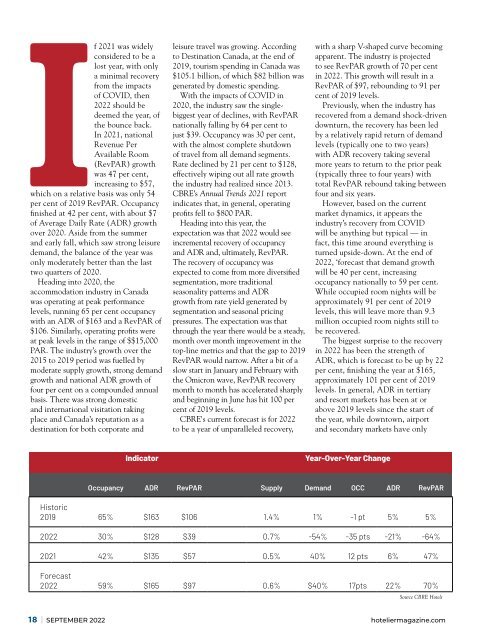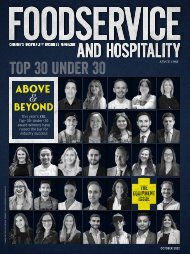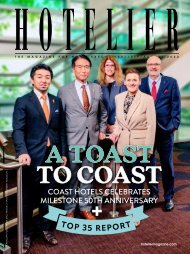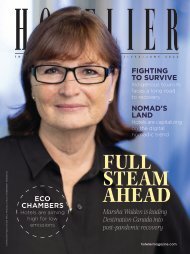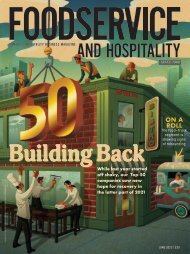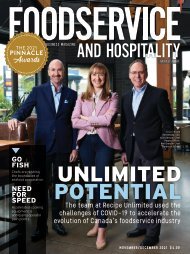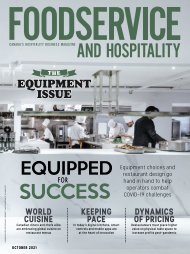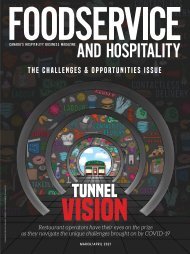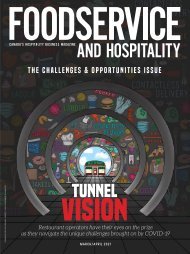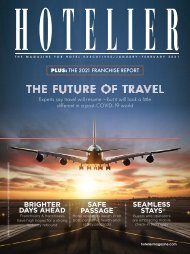September 2022 Digital Issue
You also want an ePaper? Increase the reach of your titles
YUMPU automatically turns print PDFs into web optimized ePapers that Google loves.
If 2021 was widely<br />
considered to be a<br />
lost year, with only<br />
a minimal recovery<br />
from the impacts<br />
of COVID, then<br />
<strong>2022</strong> should be<br />
deemed the year, of<br />
the bounce back.<br />
In 2021, national<br />
Revenue Per<br />
Available Room<br />
(RevPAR) growth<br />
was 47 per cent,<br />
increasing to $57,<br />
which on a relative basis was only 54<br />
per cent of 2019 RevPAR. Occupancy<br />
finished at 42 per cent, with about $7<br />
of Average Daily Rate (ADR) growth<br />
over 2020. Aside from the summer<br />
and early fall, which saw strong leisure<br />
demand, the balance of the year was<br />
only moderately better than the last<br />
two quarters of 2020.<br />
Heading into 2020, the<br />
accommodation industry in Canada<br />
was operating at peak performance<br />
levels, running 65 per cent occupancy<br />
with an ADR of $163 and a RevPAR of<br />
$106. Similarly, operating profits were<br />
at peak levels in the range of $$15,000<br />
PAR. The industry’s growth over the<br />
2015 to 2019 period was fuelled by<br />
moderate supply growth, strong demand<br />
growth and national ADR growth of<br />
four per cent on a compounded annual<br />
basis. There was strong domestic<br />
and international visitation taking<br />
place and Canada’s reputation as a<br />
destination for both corporate and<br />
Indicator<br />
leisure travel was growing. According<br />
to Destination Canada, at the end of<br />
2019, tourism spending in Canada was<br />
$105.1 billion, of which $82 billion was<br />
generated by domestic spending.<br />
With the impacts of COVID in<br />
2020, the industry saw the singlebiggest<br />
year of declines, with RevPAR<br />
nationally falling by 64 per cent to<br />
just $39. Occupancy was 30 per cent,<br />
with the almost complete shutdown<br />
of travel from all demand segments.<br />
Rate declined by 21 per cent to $128,<br />
effectively wiping out all rate growth<br />
the industry had realized since 2013.<br />
CBRE’s Annual Trends 2021 report<br />
indicates that, in general, operating<br />
profits fell to $800 PAR.<br />
Heading into this year, the<br />
expectation was that <strong>2022</strong> would see<br />
incremental recovery of occupancy<br />
and ADR and, ultimately, RevPAR.<br />
The recovery of occupancy was<br />
expected to come from more diversified<br />
segmentation, more traditional<br />
seasonality patterns and ADR<br />
growth from rate yield generated by<br />
segmentation and seasonal pricing<br />
pressures. The expectation was that<br />
through the year there would be a steady,<br />
month over month improvement in the<br />
top-line metrics and that the gap to 2019<br />
RevPAR would narrow. After a bit of a<br />
slow start in January and February with<br />
the Omicron wave, RevPAR recovery<br />
month to month has accelerated sharply<br />
and beginning in June has hit 100 per<br />
cent of 2019 levels.<br />
CBRE's current forecast is for <strong>2022</strong><br />
to be a year of unparalleled recovery,<br />
with a sharp V-shaped curve becoming<br />
apparent. The industry is projected<br />
to see RevPAR growth of 70 per cent<br />
in <strong>2022</strong>. This growth will result in a<br />
RevPAR of $97, rebounding to 91 per<br />
cent of 2019 levels.<br />
Previously, when the industry has<br />
recovered from a demand shock-driven<br />
downturn, the recovery has been led<br />
by a relatively rapid return of demand<br />
levels (typically one to two years)<br />
with ADR recovery taking several<br />
more years to return to the prior peak<br />
(typically three to four years) with<br />
total RevPAR rebound taking between<br />
four and six years.<br />
However, based on the current<br />
market dynamics, it appears the<br />
industry’s recovery from COVID<br />
will be anything but typical — in<br />
fact, this time around everything is<br />
turned upside-down. At the end of<br />
<strong>2022</strong>, ‘forecast that demand growth<br />
will be 40 per cent, increasing<br />
occupancy nationally to 59 per cent.<br />
While occupied room nights will be<br />
approximately 91 per cent of 2019<br />
levels, this will leave more than 9.3<br />
million occupied room nights still to<br />
be recovered.<br />
The biggest surprise to the recovery<br />
in <strong>2022</strong> has been the strength of<br />
ADR, which is forecast to be up by 22<br />
per cent, finishing the year at $165,<br />
approximately 101 per cent of 2019<br />
levels. In general, ADR in tertiary<br />
and resort markets has been at or<br />
above 2019 levels since the start of<br />
the year, while downtown, airport<br />
and secondary markets have only<br />
Year-Over-Year Change<br />
Occupancy ADR RevPAR Supply Demand OCC ADR RevPAR<br />
Historic<br />
2019 65% $163 $106 1.4% 1% -1 pt 5% 5%<br />
<strong>2022</strong> 30% $128 $39 0.7% -54% -35 pts -21% -64%<br />
2021 42% $135 $57 0.5% 40% 12 pts 6% 47%<br />
Forecast<br />
<strong>2022</strong> 59% $165 $97 0.6% $40% 17pts 22% 70%<br />
$31<br />
$46<br />
$55<br />
$70<br />
Confidential & Proprietary | © <strong>2022</strong> CBRE, Inc. 1<br />
Source CBRE Hotels<br />
RevPAR<br />
$180<br />
$160<br />
$140<br />
$120<br />
$100<br />
$80<br />
$60<br />
$40<br />
$20<br />
$0<br />
56%<br />
$75<br />
$42<br />
70%<br />
$88<br />
$62<br />
87%<br />
$89<br />
$78<br />
93%<br />
$95<br />
$88<br />
seen rates-exceed 2019 levels since<br />
about May. However, pricing in these<br />
markets through the peak summer<br />
season will more than offset any lag<br />
from the early part of the year.<br />
Operators have been able to<br />
drive significantly higher-thanexpected<br />
ADR levels for myriad<br />
reasons, including general economic<br />
inflationary conditions, very high levels<br />
of leisure demand due to pent-up travel<br />
desire and excess discretionary income,<br />
as well as both direct and indirect<br />
capacity constraints due to labour<br />
shortages in the hospitality, tourism<br />
and related industries. While these<br />
conditions have been favourable, it is<br />
unlikely that this level of ADR growth<br />
can continue over the longer term.<br />
CAPACITY CONSTRAINTS:<br />
A SHORT-TERM ISSUE OR<br />
HERE TO STAY?<br />
As discussed, national occupancy is<br />
expected to rebound in <strong>2022</strong> to 59 per<br />
cent, which is about six points behind<br />
the 2019 occupancy. Since early spring,<br />
89%<br />
$112<br />
$100<br />
$84<br />
105%<br />
$139<br />
$132<br />
$104<br />
$144<br />
$137<br />
Jan Feb Mar Apr May Jun Jul Aug Sep Oct Nov Dec Canada<br />
$152<br />
$142<br />
$131<br />
$107<br />
there has been considerable discussion<br />
about labour-market conditions<br />
and impact it’s having, and could<br />
continue to have, on the industry’s<br />
recovery. According to Statistics<br />
Canada, as of July 2021 there were<br />
more than 300,000 job vacancies in<br />
the Accommodation and foodservice<br />
sector, while the overall unemployment<br />
rate in Canada remains at a recordlow<br />
4.9 per cent. Many operators have<br />
indicated they’re having to restrict<br />
capacity (i.e. available rooms) in order<br />
to ensure their ability to service guests<br />
and turn over rooms on departure.<br />
At this point, it’s not possible to<br />
quantify the exact extent to which this<br />
restricting of capacity could be limiting<br />
the ability to capture additional<br />
occupied room nights, as this is being<br />
done at the property level in most<br />
cases on a week-to-week basis. To this<br />
point, the restricted capacity has been<br />
mostly favourable as it has allowed<br />
operators to drive rate yield on the<br />
demand they are able to accommodate.<br />
However, as other demand segments<br />
$107<br />
$86<br />
<strong>2022</strong> F <strong>2022</strong> A 2019 Recovery A<br />
$91<br />
$80<br />
$75<br />
$70<br />
$106<br />
$97<br />
120%<br />
110%<br />
100%<br />
90%<br />
80%<br />
70%<br />
60%<br />
50%<br />
40%<br />
30%<br />
20%<br />
10%<br />
0%<br />
Recovery to 2019 Levels %<br />
with negotiated or contracted rates this<br />
dynamic will likely shift.<br />
While some relief is expected<br />
to come from Canada’s increased<br />
immigration targets and the recent<br />
changes to the foreign-workers<br />
program, there are several other<br />
industries where there are high levels of<br />
job vacancies, which will compete for<br />
new workers with the accommodation<br />
sector. As such, it’s unlikely the labour<br />
challenges will subside quickly, and this<br />
may be an issue that persists for the<br />
next several years. It will be necessary<br />
to evaluate the impact of restricted<br />
capacity on the industry’s ability to<br />
ramp-up occupied room night demand<br />
back to 2019 levels.<br />
RECOVERY TO 2019 LEVELS: IS<br />
IT THE RIGHT BENCHMARK?<br />
Historically, when judging or<br />
benchmarking the industry’s recovery<br />
from a downturn, it’s been with a<br />
view to getting back to the prior peak.<br />
After surviving the initial months of<br />
COVID, the discussion turned to what<br />
18 | SEPTEMBER <strong>2022</strong><br />
hoteliermagazine.com hoteliermagazine.com<br />
SEPTEMBER <strong>2022</strong> | 19


